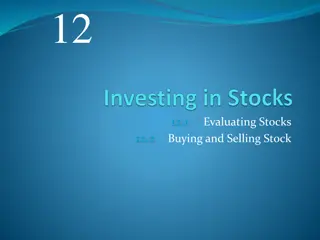Understanding Preferred Stocks: Characteristics, Advantages, and Analysis
Preferred stocks are hybrid securities with characteristics like paying dividends and having equity ownership. They offer advantages such as high current income, safety, and low unit cost, while lacking capital gain potential. The usual features include nonvoting status, callability, sinking fund agreements, and cumulative dividends. Yields are typically higher than bonds, but tend to be unstable. Analysis involves evaluating asset values and ratings. Overall, preferred stocks provide a unique investment option with both benefits and risks.
Download Presentation

Please find below an Image/Link to download the presentation.
The content on the website is provided AS IS for your information and personal use only. It may not be sold, licensed, or shared on other websites without obtaining consent from the author. Download presentation by click this link. If you encounter any issues during the download, it is possible that the publisher has removed the file from their server.
E N D
Presentation Transcript
Preferred Stocks & Convertibles Topic 8 I. Preferred Stocks 1
A. Characteristics 1. Hybrid Securities a. Pay Dividends b. Equity Ownership c. Prior Claim d. Fixed Dividends Bond CS CS Bond 2
A. Characteristics (continued) 2. Advantages / Disadvantages a. High Current Income b. Safety c. Low Unit Cost ($10-$25/Share) d. Inflation -- not a good hedge e. Lacks capital gain potential 3
A. Characteristics (continued) 3. Sources of Value a. Dividend Yield P = D / K D = Dividend K = Required Return 4
B. Usual Features of Preferred Stock 1. Voting Usually nonvoting but does have contingent voting rights. This is the right to elect some of the directors. Usually have the right to vote for approval on the issuance of additional Preferred Stock. 2. Maturity and Call Typically Preferred Stock has no maturity date (like C/S). The typical Preferred is callable. 5
B. Usual Features of Preferred Stock (continued) 3. Sinking Fund 40% of Preferred issues have this agreement, usually found in public utility Preferred 4. Dividends Cumulative VS Noncumulative 5. Convertibility Preferred is typically nonconvertible 1/3 of Preferred are convertible 6
C. Yields 1. Compared with Bonds, Preferred are typically higher. Why? 2. Pattern Similar to Bonds 3. Yields have tended to be relatively unstable. This suggests a higher degree of risk. 7
D. Analysis of Preferred Stock 1. Assets/Share Example: Assume: TA = $110 TD = $50 1 million Preferred Shares with $10 par The Net Asset/Share would be $60 million = $60/Share 1 million shares This would cover Par 6 x 8
D. Analysis of Preferred Stock (continued) 2. Preferred Stock Ratings S&P Rating : AAA to C 9
E. Preferred Stock as an Investment 1. Better suited for the Institution 2. Does not share in earnings 3. Does not have the security of Bonds, more volatile 4. Only becomes attractive when the yield is greater than Bonds 10
Preferred Stocks & Convertibles Topic 8 II. Convertible Securities 11
A. Characteristics 1. Hybrid possessing the features and performance qualities of both fixed income and equity securities 2. Should be viewed primarily as a form of equity 3. Provide the Equity Kicker 4. A Deferred Equity 12
B. Convertible Bonds 1. Issued as Debentures 2. Over time, may be converted into a certain number of shares 3. Normally Freely Callable which may lead to Forced Conversion 13
B. Convertible Bonds (continued) 4. Options at forced conversion Convert to shares Redeem the Bond for cash at the stipulated call price 5. Conversion Privilege Stipulates the conditions and nature of the conversion Initial waiting period of 6 months to 2 years Conversion period may have a limited life 14
B. Convertible Bonds (continued) 6. Conversion Ratio Number of common shares which the Bond may be converted into Example: A Ratio of 20 states that a $1000 Bond may be converted into 20 shares of the Common Implied conversion price is $50/Share Ratios are normally fixed but can be variable Ratios are adjusted for stock splits 15
C. Sources of Value of Convertibles 1. Convertible Securities trade like a Common Stock. They derive value from the Common Stock. Example: Assume a Convertible has a ratio of 20 and the Stock sells for $45. If the conversion price is $50 ($1000/20), then for every point the stock goes up or down the Convertible Security will move by 20x. Hence, Price of Convertible Security in example is: $45 * 20 = $900 16
D. Risk 1. Risk is a function of the issue s fixed income and equity characteristics. 2. Fixed income nature defines its floor price. 3. Equity nature defines its ceiling price. 17























